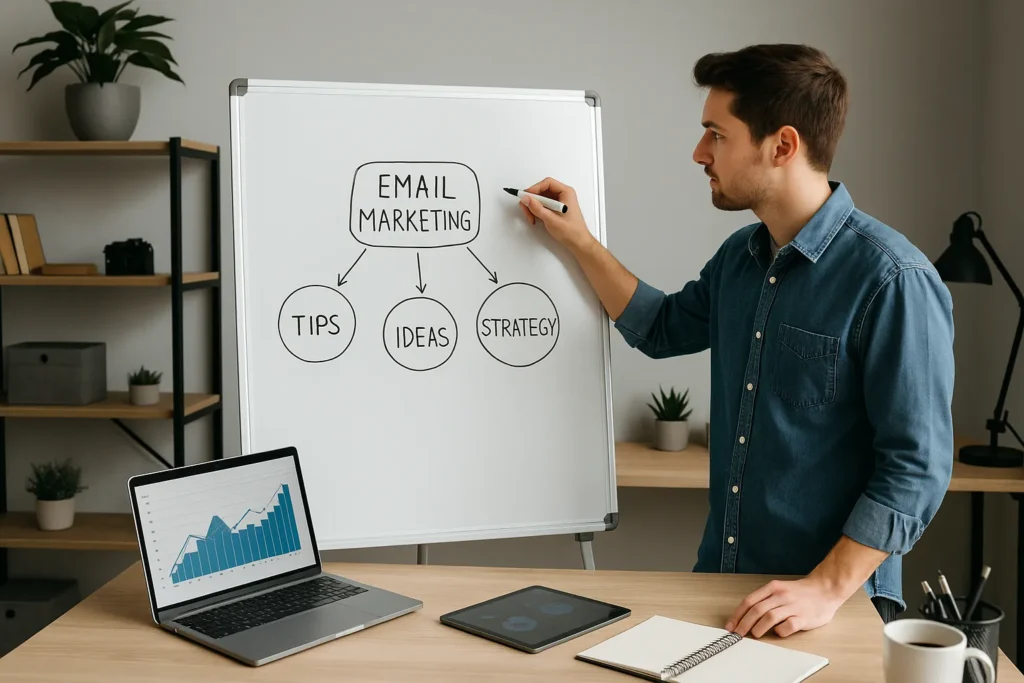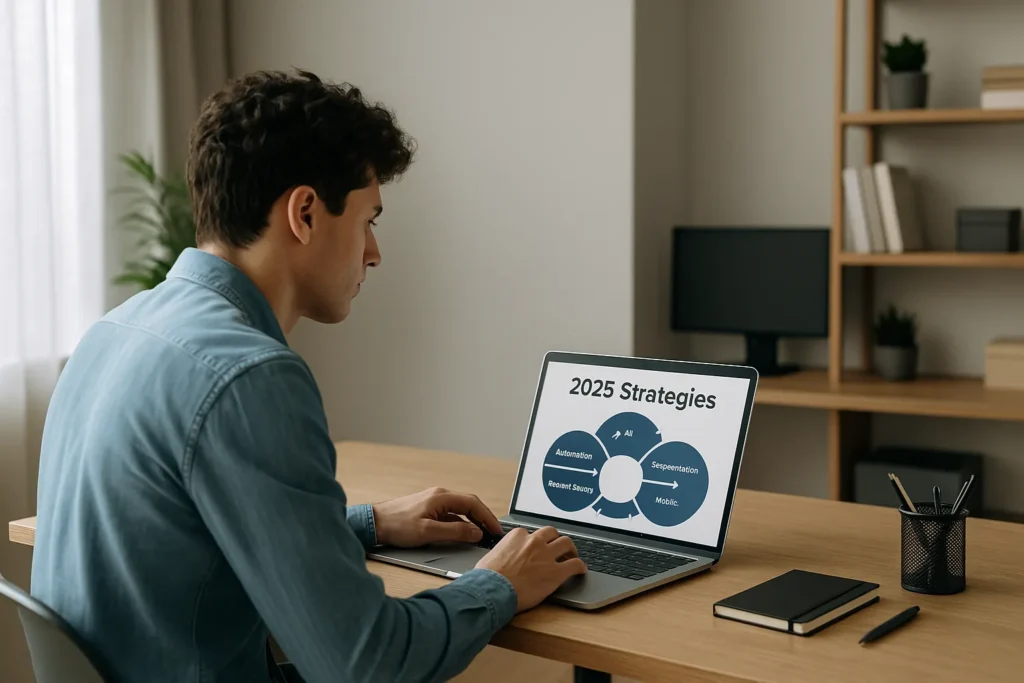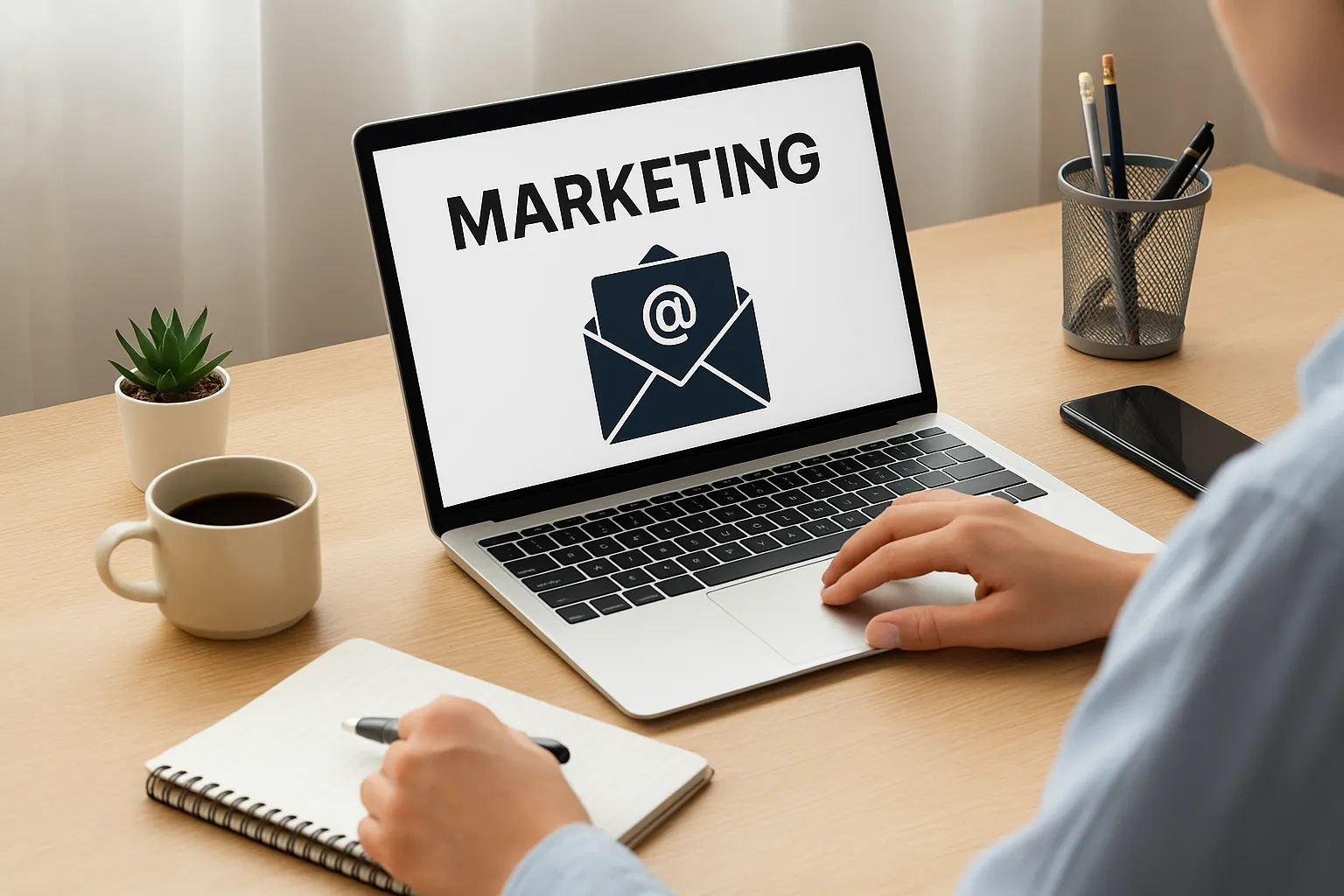Email Marketing Done Right: Strategies That Still Deliver in 2025
More than 4 billion people use email every day. It’s still one of the highest-ROI tools in your marketing toolbox.
Why? Because when someone opens your email, they’ve already chosen to hear from you. That makes email different from social media, ads, or cold calls.
In this guide, you’ll find the email marketing tips that are actually working in 2025. We’ll show you how to improve your subject lines, send better welcome emails, and boost your click-through rate. You’ll also learn how to build trust, keep subscribers engaged, and avoid the spam folder.
The best part? These strategies are practical. You don’t need to be technical or use complicated tools. You can do this.
Ready? Let’s get started.
Smart Email Marketing Tips That Actually Work
Writing a marketing email can feel like yelling into the void. You hit send, cross your fingers, and hope that at least your mum opens it.
But email marketing doesn’t have to be a mystery. You only need a few tricks that still work, even in 2025.
Here’s how to turn a boring email into one that gets opened, read, and clicked:

- Sounds like a human. People don’t connect with buzzwords or robotic phrasing. They connect with clear, friendly messages. Pretend you’re explaining something to a mate over coffee. That tone builds trust.
- Send the right message to the right group. Don’t treat your list like one big bucket. Segment it. If someone signed up for updates, don’t immediately pitch them your product. That’s how you lose interest fast.
- Automate, but don’t zone out. Scheduling is great, but don’t let it run without checking in. Weird timing or stale copy can make you look careless. Read your own automations once a month like a subscriber would.
- Test different send times. No, there isn’t one perfect hour for everyone. Try sending your email in batches: morning, afternoon, evening. Also, track what gets results.
- Double-check your writing. Out loud. Always. You’ll catch clunky sentences, awkward phrasing, and tone issues fast. Even better, ask a friend to read it.
Pro tip: Email marketers who test subject lines and segment lists often see more opens and better engagement.
How to Plan Email Marketing Campaigns That Succeed
Most email marketing campaigns fall short because there’s no plan, just a message written on a deadline and fired out to everyone at once.
But a little structure can change everything. No complicated system required, just follow these three steps.
Set a Clear Goal
Before you start writing anything, decide what you want the email to do. Is the goal to get people to click a link? Make a purchase? Register for something? Keep it to one outcome. If you’re not sure what the goal is, the reader won’t be either. When your message supports a single purpose, the results usually follow.
Create a Simple Schedule
Now, work out when and how often you’ll send your emails. This might be a one-off campaign or a short series of two or three emails. Write out what goes out on which day and why. This small habit can stop last-minute scrambles and help you stay consistent. You don’t need a spreadsheet, just a plan that makes sense to you.
Try Something, Then Improve It
The best email marketing strategy includes room to learn. Try sending two versions of a subject line or call to action. Watch which one performs better. Even basic testing helps you spot what works and what flops.
Make Your Subject Line and Sender Name Stand Out
Your subject lines and sender name are the first things people notice. Get them wrong, and your email heads straight to the trash. Get them right, and you’ll see more openings. You’ll also see more clicks.
A few simple tweaks can make a big difference:
| Subject Line Tip | Why It Works |
| Ask a question | Curiosity encourages a click |
| Add a name or location | Feels personal and localised |
| Use fewer than 10 words | Stays visible on mobile devices |
| Try different subject lines | Helps you find what gets attention |
Want a practical check? Paste your email subject lines into SendCheckIt to see how they score before sending.
The sender’s name also matters. People ignore anything that looks like a system message or a no-reply address. Use a name they’ll recognise, like “Ava from Spotly.” Or include your brand if it feels natural.
Pair a good subject line with a friendly sender name. This increases the chance people will open and act on your message.
Pro Tip: A clear subject and a trustworthy sender make your call to action more likely to get clicked.
The Secret to Writing Great Welcome Emails
Welcome emails are your first proper handshake with a new subscriber. It’s your moment to make a good impression. At this stage, they haven’t formed an opinion about your tone, your brand, or your intentions.
That’s why the best welcome emails feel like they’re from a person, not a system. They are friendly, helpful, and short. They set expectations clearly and offer something useful without jumping into a sales pitch.
Start by saying hello. Let your new subscribers know what they’ll be getting from you. Will it be weekly tips, product updates, or occasional offers? Be upfront. This helps manage expectations and can reduce unsubscribes.

Next, offer something small but valuable. It might be a free guide, a helpful blog post, or even a simple tip. If you promised a lead magnet, this is the moment to deliver.
Include one clear call to action. Ask them to check out a blog post, follow you on social media, or hit reply. Just pick one thing and keep it simple.
If you’re confused about how to start, look through the email templates in your email service provider. Choose one that feels clean, then rewrite it to sound more like you.
Welcome emails are simple. But done well, they start your relationship on the right foot.
Simple Ways to Increase Click Through Rate
Getting people to open your email is only half the battle. The real value comes when they click. That’s where your click-through rate tells the story.
Here are some easy ways to make more people click without guessing your way through it:
- Use one call to action. If you ask someone to do five things, they’ll likely do none. Focus on one next step, like reading a blog or checking a product page.
- Make the link obvious. Buttons work well. Big, bold, and clear beats small and subtle. Don’t hide links in long paragraphs.
- Test your layout on mobile devices. If your links or buttons are too close together, you’ll lose clicks from frustrated thumbs. Preview your email on phones before sending.
- Use action words. “See how it works” is more clickable than “Click here.” People need to know what they’re getting.
- Try basic A/B testing. Split your list in half. Use a different subject line or button in each version. See which one gets more clicks, then build on it.
Key Takeaway: A higher click-through rate doesn’t mean shouting louder. It means making the action obvious, simple, and easy to take.
Re-Engagement Emails: Wake Up Your Quiet Subscribers
Not every subscriber stays active. People get distracted, change inboxes, or just tune out for a while. That doesn’t mean they’re gone forever.
Re-engagement emails give you a chance to check in, remind them why they signed up, and offer something fresh. These aren’t sales emails. They’re a simple “Hey, still with us?” sent with care.
A great re-engagement email often includes something new or unexpected. Maybe it’s a recent post that performed well. Maybe it’s a discount, a guide, or a fresh offer. Keep it friendly and light. Avoid guilt or pressure.
You can also give them options. Let them choose to get fewer emails instead of unsubscribing altogether. This often reduces unsubscribe rates and gives people more control over what they see.
Pro Tip: Want a simple way to encourage subscribers to stay? Add a one-question poll asking what they want to hear about next.
The Engagement Metrics That Really Matter
It’s easy to get distracted by numbers that look good on a dashboard but don’t tell you much. Not every stat deserves your attention.
If you want to know whether your email marketing is actually working, focus on the metrics that show real interest and action. These are the ones that help you improve, not just impress.
- Click-through rate. This tells you who clicked on a link inside the email. For example, if 100 people opened the message and 20 clicked your call to action, that’s a 20% rate. Higher CTR often means your message was clear and your offer was appealing.
- Reply rate. If people respond to your message, they’re engaged. This is especially useful for service businesses or campaigns that ask for feedback or referrals. Even a few replies can signal trust and real interest.
- Read time. Some platforms show how long readers spend on your email. If most people skim and leave in under five seconds, you may need to simplify your layout or make the opening line stronger.
- List churn. Track unsubscribes, hard bounces, and spam complaints. A slow trickle is normal. A sharp rise means it’s time to rethink your content, subject lines, or frequency.
- Conversion rate. This is the finish line. If people click and then buy, book, or sign up, your entire flow works.
These are the key performance indicators worth checking every week. Good engagement metrics are like feedback from your readers. They show you what to keep and what to change.
How to Attract Better Email Subscribers
Anyone can grow a big email list. But size doesn’t mean much if the people on it don’t care about what you send.
The goal isn’t just more email subscribers. The goal is to be better ones. These are the people who actually want to hear from you, click your links, and take action when it counts.

Here’s how to bring in more of the right kind of subscribers:
- Offer something valuable. Give your target audience a reason to sign up. That might be a checklist, a discount, a quick-start guide, or any small win that solves a problem.
- Place your form where people look. Add it to blog posts, product pages, and your homepage. Use pop-ups, but time them well. Don’t interrupt too early.
- Be clear about what they’ll receive. Let them know how often you’ll email and what kind of content to expect. This helps build trust and lower unsubscribe rates.
- Keep the form simple. Ask for contact details like name and email only. Too many fields often scare people off.
- Clean your customer data. Use double opt-ins or email verification to avoid fake addresses.
Match Every Email to a Landing Page That Converts
Your email campaign isn’t finished when someone clicks. The landing page that comes next is where they decide whether to act or exit.
To keep them engaged, your email and landing page need to feel like two parts of the same conversation.
Keep the Message Consistent
If your email promotes a free guide, make that guide the very first thing they see. Don’t distract them with other promotional messages. Repeat the headline or offer from your email on the page. This kind of message match builds trust instantly.
Design for Mobile First
Over 60% of email marketing clicks happen on mobile devices. Your landing page should be built for thumbs, not mouse clicks. Use large fonts, clear headings, and a call to action button that’s easy to tap. Blue, green, and orange tend to perform well for buttons; just make sure they stand out from your background.
Test on real phones before launch. Don’t rely on desktop previews.
Match the Tone and Layout
Use the same brand colours, fonts, and writing style across both the email and landing page. If your email is casual and friendly, the page should be too. This creates a smoother transition and helps users stay focused.
Track and Improve
Use Google Analytics to track clicks and page behaviour. Tools like Hotjar can show you heatmaps and scroll depth so you can see exactly where people stop reading. If people bounce early, try simplifying your message or moving the button higher up.
Make Sure Your Emails Actually Land in the Inbox
Even the best-written email won’t do much if it ends up in the spam folder. That’s why email deliverability should be part of your strategy from day one.
These simple checks can help more of your messages land where they belong:
- Authenticate your domain. Most email service providers give you DNS records like SPF, DKIM, and DMARC to copy into your domain settings. These verify that you’re a real sender and not spoofing someone else’s identity.
- Watch your sender reputation. If people mark your emails as spam or if you get too many bounces, your domain’s trust score drops. Keep your list clean and avoid sending to contacts who never open.
- Don’t use spammy language. Phrases like “Act now,” “100% free,” or “You’ve been selected” can trigger filters. Keep your tone helpful, not hyped.
- Send at a steady pace. Sending to a huge list all at once, especially from a brand-new domain, can hurt deliverability. Start small and gradually increase volume.
- Test before you send. Use Mail-Tester to get a free score on your deliverability. It checks for technical issues, blacklists, and spam signals.

Good email marketing starts with getting seen. Strong email deliverability helps your content land where people can actually read it.
Keep It Simple, Keep It Honest
Clear, helpful emails often perform better than clever ones. When your message is easy to understand and sounds like it came from a real person, people are more likely to open, read, and trust it.
You now have practical ways to improve your email marketing. Write subject lines that make people curious. Clean your list so you’re talking to the right audience. Match your landing pages to your message so people stay engaged.
If you’re ready to turn better emails into more site visits, Website Traffic Increaser Guy helps businesses do just that. They focus on growing traffic through strategies that are proven to work, not just trendy ideas.
Choose one thing from this guide and try it this week. Then keep building from there.
